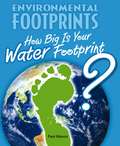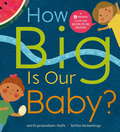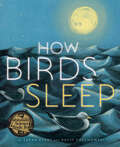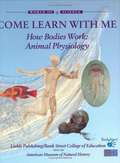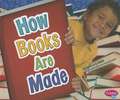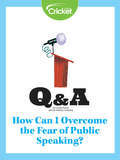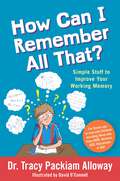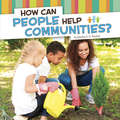- Table View
- List View
How Big Is Your Water Footprint? (Environmental Footprints)
by Paul MasonWhat sort of footprint are you leaving on the environment? Do you have a heavy footprint or a light footprint? Everything we do and everything we use has an impact on the environment. Heavy footprints harm the environment and use lots of natural resources. Light footprints harm the environment as little as possible and use fewer natural resources. In How Big Is Your Water Footprint? read about what makes up a water footprint and the effect this has on the environment. Discover ways to reduce your water footprint and live sustainably. Special features: Rethink! feature offers ways to lighten your footprints. Case studies give real-life examples of heavy-footprint and light-footprint actions.
How Big is Our Baby?: A 9-month guide for soon-to-be siblings
by Smriti Prasadam-HallsWhen a new baby is on the way, siblings-to-be have lots of feelings and plenty of questions. But whether they're impatient, curious or a little worried, this friendly and reassuring guide explains each step of the pregnancy journey and helps little ones feel involved and excited. With a month-by-month approach that compares the size of the growing baby to something familiar to the young reader, such as a speck of sand at the seaside or an egg, readers also find out about how Baby is developing, from when the heart might first beat to when they'll be able to feel it kick. The book also includes information about how life might change once Baby arrives, and how exciting it will be to have a new baby brother or sister.
How Big is a Foot?
by Rolf MyllerWith the Queen's birthday only days away, the King is concerned that the royal carpenters will not be able to build her a bed because they do not know how to measure.
How Birds Sleep
by David ObuchowskiDiscover the mysterious and fascinating sleeping habits of more than twenty bird species from around the world in this gorgeously illustrated read-aloud picture book, perfect for bedtime, or any time.Have you ever seen a bird sleep? Or wondered just when it is that migrating cranes find the time to catch Z&’s as they cross the ocean? From the parrots of Thailand to the ostriches of Australia and even the pigeons of New York City, every bird sleeps—but they do it in ways that will surprise and delight you. Some hang from tree branches, others doze while gliding, and some even burrow underground for a nap. Written in a witty, conversational voice, and with gorgeous illustrations, this picture book is bursting with interesting facts about this underexplored aspect of bird life all around us.
How Bodies Work: Animal Physiology
by Bridget AndersonDo you ever wonder what makes you grow? Or why you shiver when you are cold? Have you ever marveled at the speed of a cheetah, the fastest land animal on Earth? Or been awed at how a chameleon can change color? Solving such mysteries is part and parcel of animal physiology, the science that investigates how different animal bodies work. Learning how they do increases our appreciation of the uniqueness and diversity of the vast animal kingdom, and adds to our understanding of how our own bodies work. HOW BODIES WORK: ANIMAL PHYSIOLOGY offers a glimpse inside ourselves and the amazing world around us.
How Books Are Made
by Martha E. H. RustadTo make a book, you first start with an idea. What comes next? Crack open the cover to find out how books are made.
How Can I Be a Detective If I Have to Babysit?
by Linda BaileyDetective Stevie Diamond and her partner, Jesse Kulniki, take off for her dad's tree-planting camp in desperate need of adventure. What they find is a job taking care of five-year-old Alexander Creely. It's insulting! Stevie is steaming until she hears about Rubberface Ragnall--a smuggler who has been ransacking Alexander's trailer. Suddenly, baby-sitting seems the perfect job for the Diamond and Kulniki Detective Agency.
How Can I Overcome the Fear of Public Speaking?
by Lizzie WadeSome people are afraid of public speaking more than others. Learn about some surprising ways to overcome stage fright.
How Can I Remember All That?: Simple Stuff to Improve Your Working Memory
by Tracy Packiam Packiam AllowayWhy can't I remember what my parents just asked me to do? Why do I feel stressed out at school when the teacher is writing on the board and talking at the same time? And what can I do about it? Working memory issues affect a huge proportion of kids with learning differences like ADHD, dyslexia, dyscalculia, and ASD. These issues can make them feel frustrated or bored, as working memory and intelligence are two very different things. Kids with working memory problems can also act out in the classroom and at home. In this child-friendly and authoritative guide, international working memory expert Dr Tracy Packiam Alloway walks you through what working memory is, what it feels like to have problems with your working memory, and what you can do about it. She presents key tips and strategies, such as the benefits of eating chocolate or of barefoot running, that will help children both at home and at school, and includes a section at the end for adults describing how we can test for working memory issues.
How Can People Help Communities? (Community Questions)
by Martha E. RustadA community is only as strong as its individual members. What roles do those members play, and how do citizens work together to complete common tasks and achieve goals? A clear question-answer format, paired with photos kids can relate to, shows the importance of responsibility and cooperation. A simple activity encourages young readers to actively participate in their own community.
How Can Some People Be Good at Singing?
by Lizzie WadeSome people are better at singing than others. Why is that? A researcher explains why some people love doing karaoke, and others simply can't do it.
How Carrot and Cookie Saved Christmas
by Erica S. PerlA festive pun-filled story perfect for the holidays!In this follow-up to When Carrot Met Cookie, Christmas is fast approaching, and Carrot and Cookie are both worried—they can't find the right present for each other! But when they hear a crash on Christmas Eve and find a sick Santa too ill to keep flying his sleigh, they know there are more important matters at hand. Can these friends conjure up enough Christmas magic to step into Santa's shoes, deliver the presents themselves, and save the day? Hilarious and heartwarming, this is the perfect gift for future foodies or anyone looking for some special holiday cheer.
How Cars Changed The World
by Kurt HoffmanBright, full-color and black and white historic photographs compare and contrast the cars, roads, and travel experiences of today with those of days gone by. Strongly correlated to the Common Core Standards for Informational Text, this title is perfect for exploring the relationships between a series of historical events and scientific ideas.
How Caterpillars Turn Into Butterflies (Nature's Mysteries Ser.nature's Mysteries)
by Jill BaileyYoung readers can learn about many of the most amazing aspects of nature in this strikingly illustrated set of books. Ideal for the reader who must know how nature works, this series has the answers to many questions, helping to open up the world of nature's secrets.
How Chipmunk Got Tiny Feet (Native American Animal Origin Stories)
by Gerald HausmanHow Coyote got yellow eyes, How Bat learned to fly, How Lizard got flat, How Hawk stopped the flood with his tail feather, How Horse got fast, How Possum lost his tail, and How Chipmunk got tiny feet.
How College Affects Students: A Third Decade of Research
by "Ernest T. Pascarella Patrick T. Terenzini"This is the long-awaited second volume of Pascarella and Terenzinis 1991 award-winning review of the research on the impacts of college on students. The authors review their earlier findings and then synthesize what has been learned since 1990 about colleges influences on students learning.
How Come the Best Clues Are Always in the Garbage? (Stevie Diamond Mystery #1)
by Linda BaileyStevie Diamond and her friend Jesse have a thief to catch. A thousand dollars is missing from her mother's apartment and although there are lots of suspects, there aren't very many clues. A worthy challenge for Stevie Diamond, Detective! Set in Vancouver, the very first Stevie Diamond Mystery is a funny and entertaining read.
How Come?: Every Kid's Science Questions Explained
by Kathy WollardFact-filled, fun-filled, as interesting to parents as it is to kids, the How Come? series is the trusted source for lively, clear answers to kids’ science queries. Now the best questions and answers from all three books—How Come?; How Come? Planet Earth; and How Come? In the Neighborhood—have been revised, updated, freshly illustrated in full color, supplemented with twenty completely new questions, and combined into one bigger, better volume. How Come? explains, in fascinating detail, more than 200 mysteries and phenomena in the world around us. These are the questions that pique kids’ curiosity—and stump parents.When it rains, does running (rather than walking) to the nearest shelter really keep you any drier? How can a stone skip across a pond (instead of sink)? If the Earth is spinning, why can’t we feel it? Why don’t we fly off? Why do elephants have trunks? And the all-time classic, Why is the sky blue? (Sunlight has a hidden rainbow of colors, and air molecules scatter blues the most—sending bright blue light down to Earth.) The text is clearly written, engaging, and accessible. It’s for every kid who wants to know—and every grown-up who simply doesn’t know.
How Could a Bear Sleep Here?
by Julie GonzalezIt's time for Shelby to hibernate, but how could a bear sleep in this noisy forest?The woodpeckers are rat-tat-tatting, the squirrels are cracka-cracka-crunching--there's too much noise! When Shelby spies the perfect cave, only too late does he realize he's hopped aboard a tour bus bound for the beach.Coupled with hysterically expressive illustrations by Stephanie Laberis, Julie Gonzalez's lively text and familiar refrain sings as Shelby, after several attempts to snooze in the tropics with increasing exhaustion, finally discovers the perfect solution to his noise problem. This is a great read-aloud for young readers who will recognize the refrain ("How could a bear sleep here?") and the silliness of Shelby's predicament
How Davy Crockett Moved the Sun: An American Tall Tale
by Carol Pugliano-Martin Jeffrey Fuerst Dewayne WhitesidePerform this American tall tale about how Davy Crockett moved the sun.
How Deep Is Your Love: A Children's Picture Book
by Bee GeesA majestic picture book based on the Bee Gees's classic love song "How deep is your love? I really mean to learn 'Cause we're living in a world of fools Breaking us down When they all should let us be We belong to you and me . . ." How Deep Is Your Love is a fantastical picture book based on one of the Bee Gees's biggest hits. The song topped the Billboard Hot 100 chart, remaining in the top ten for seventeen weeks, and won the band's first of eight GRAMMY awards. With lyrics by the Bee Gees and illustrations by J.L. Meyer, the picture book tells the tale of two bunny mermaids who meet on a rock and descend into the water together. As the bunnies escape traps, skirt around nets and hooks, and protect each other in this thrilling adventure, they realize how deep their love is. Meyer's imaginative story compliments the hit song perfectly and will delight children and adults alike.
How Deep Is the Ocean? (Let's-Read-and-Find-Out Science 2)
by Kathleen Weidner ZoehfeldRead and find out about the deepest part of the ocean in this colorfully illustrated nonfiction picture book.The ocean covers almost three-quarters of the Earth, but how deep does it go? Put on your scuba gear and explore the ocean, from its shallowest waters to its deepest, most mysterious parts. As you dive deeper, you’ll discover glowing animals, strange creatures that don’t need sunlight to survive, and even the largest hunter in the world.With beautiful illustrations and engaging text, How Deep Is the Ocean? will guide young readers into the deepest parts of the ocean. Featuring a find-out-more section with a water-pressure experiment, a lesson in making a sounding line to learn how scientists measure the depth of the ocean, a glossary of new terms, and web research prompts, this book will begin children’s explorations of the deep sea. Both the text and the artwork were vetted for accuracy by Dr. David Gruber, real-life deep sea explorer and professor of biology and environmental science at Baruch College.This is a clear and appealing science book for early elementary age kids, both at home and in the classroom. It's a Level 2 Let's-Read-and-Find-Out, which means the book explores more challenging concepts for children in the primary grades. The 100+ titles in this leading nonfiction series are:hands-on and visualacclaimed and trustedgreat for classroomsTop 10 reasons to love LRFOs:Entertain and educate at the same timeHave appealing, child-centered topicsDevelopmentally appropriate for emerging readersFocused; answering questions instead of using survey approachEmploy engaging picture book quality illustrationsUse simple charts and graphics to improve visual literacy skillsFeature hands-on activities to engage young scientistsMeet national science education standardsWritten/illustrated by award-winning authors/illustrators & vetted by an expert in the fieldOver 130 titles in print, meeting a wide range of kids' scientific interestsBooks in this series support the Common Core Learning Standards, Next Generation Science Standards, and the Science, Technology, Engineering, and Math (STEM) standards. Let's-Read-and-Find-Out is the winner of the American Association for the Advancement of Science/Subaru Science Books & Films Prize for Outstanding Science Series.
How Did Humans Go Extinct?
by Paul Hoppe Johnny MarcianoLet’s learn about the most mystifying species to ever walk the Earth!“A clever . . . way to bring awareness to the very real threats to humanity posed by war, climate change, and capitalism. A compelling and unique dystopian sci-fi picture book for early school age readers, this is recommended for all collections.” —School Library JournalPlib is like every other Nøørfbløøk kid on Earth, except for one thing.He loves humans—those horrible, terrifying monsters who dominated the planet ten million years ago.Only one thing about the humans bothers Plib. What happened to them all? Did they turn the planet into an uninhabitable wasteland? Or did they turn on each other? Or did the humans die out because of something else they did—or didn’t—do?Find the answer in How Did Humans Go Extinct?
How Did I Begin?
by Mick ManningIf you choose to share 'the facts of life' with children at a young age, this is the perfect book to do so. It gently guides the reader through each stage of a child's development within the womb with charming illustrations and simple explanations, inviting lots of discussion and providing answers to all those questions. Shortlisted for the Junior Science Book Award (now the Royal Society's Science Prize).
How Did I Get Here?
by Philip BuntingThis is the unathorised biography of you. Charting your incredible journey from Big Bang to birth (in about the time it takes to eat your breakfast), Philip Bunting's hilarious and one of a kind history of evolution was created to raise more questions than it answers. Perfect for fans of Jon Klassen and Chris Haughton.
